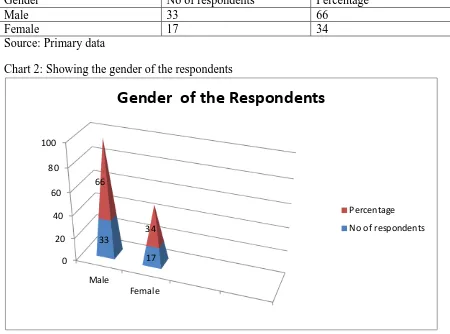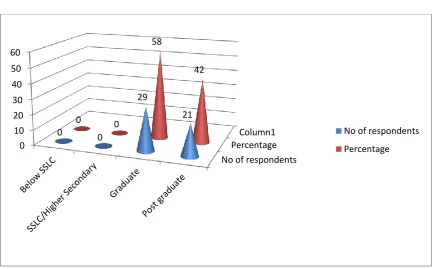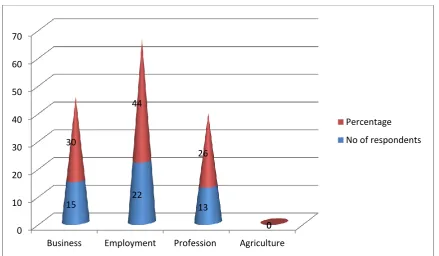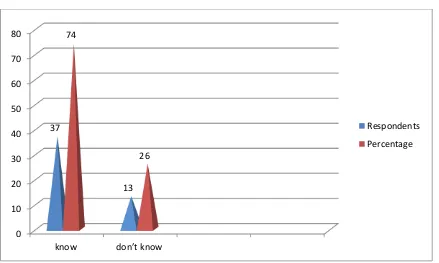Available online: https://pen2print.org/index.php/ijr/ P a g e | 370
"A study on the Investment Behaviour towards Systematic Investment Plan
of Mutual Fund”
Mr. Shiva Kumar H.N, Assistant Professor, Department of PG Studies in Commerce, Alvas College , Moodabidri, shivakumarhn84@gmai.com
Nisha k, Lecturer in Management and HRD, Alvas college Moodabidri, nishakhanderi1994@gmail.com
Abstract: The mutual fund is an indirect investment help the investor to diversify the investment in different avenues. These help investors in several ways by giving different opportunities to invest in the schemes. This study had made attempt to know the investors buying factors and the decision towards the mutual fund. In order to achieve these objectives a structed questionnaire is prepared and distributed to 50 respondents of Mangalore region and based on the responses findings and suggestion is drawn.
Introduction:
Orderly Investment Plan is a keen extremely to make riches. It doesn't request single amount ventures. Only a little, consistently. Additionally? With SIP, you don't have to time the market. Over a long stretch, your venture midpoints out the market highs and lows. Subsequently you purchase more units when the market is low and less when the market is high. Taste is really little on reserve funds and enormous on advantages. In this way, build up a decent propensity for general reserve funds. Specialists continue saying that the best time to purchase is when markets are falling and the correct time to offer is the point at which the market is topping, it's recently impractical for an ordinary speculator since when the market is falling it's hard to purchase. In any case, contributing through SIPs help one dodge the slip-up of purchasing progressively when the market crests and less when the market fall.
FEATURES
1. Train: The cardinal control of building your corpus is to remain cantered, put frequently and keep up train in your contributing example. A couple of hundreds put aside consistently won't influence your month to month discretionary cashflow. You will likewise think that its less demanding to part with a couple of hundreds consistently, as opposed to set aside a vast whole to invest in one shot.
Available online: https://pen2print.org/index.php/ijr/ P a g e | 371 advantage of aggravating. How about we clarify this with a case. Individual A began contributing Rs, 10,000/ - every year at 30 years old. Individual B began contributing a similar sum each year at 35 years old. When they accomplished the age of 60 individually, A had assembled a corpus of Rs. 12.23 lakh while individual B's corpus was just Rs. 7.89 lakh. For this illustration, a rate of return of 8% intensified has been expected.
3. Rupee Cost Averaging: This is particularly valid for interests in values. When you put a similar sum in a reserve at customary interims after some time, you purchase more units when the cost is lower and less units when the costs are higher. Along these lines, you would diminish your normal cost per share (or per unit) after some time. While making little speculations through SIP may not appear to be engaging at in the first place, it empowers speculators to start sparing. Throughout the years, it truly can include and give you attractive returns. A month to month SIP of Rs. 1000 at the rate of 9% would develop Rs. 6.69 lakh in 10 years, Rs. 17.83 lakh in 30 years and Rs. 44.20 lakh in 40 years. Notwithstanding for the money rich, SIPs diminishes the shot of contributing at the wrong time and losing their rest over a wrong speculation choice. In any case, contributing at lower levels determines the genuine advantage of a SIP.
4. Accommodation: This is an exceptionally advantageous method for contributing. You need to simply submit checks alongside the topped off enrolment frame. The common store will store the keeps an eye on the asked for date and credit the units to one's record and will send the affirmation for the same.
Review of literature
Nalini Prava Tripathy (1996) pointed that, mutual funds creates awareness among urban and rural middle class people about the benefits of investment in capital market, through profitable and safe avenues. Mutual fund could be able to make up a large amount of the surplus funds available with these people.
Raja Rajan (1997,1998) high helped division of speculators on the premise of their qualities, venture size, and the connection between stage in life cycle of the speculators and their venture.
Terrance (1998) analyzed the conduct of individual financial specialists and discovered them displaying demeanour impacts, that is, they understand their beneficial stocks require as speculation at a significantly higher rate than their unfruitful ones. The demeanor impact is found to impact showcase cost; yet its financial criticalness is probably going to be the best for individual speculators.
Background of the study
Investment is an important aspect for an investor he invest his savings for various reasons some time he invest for the return
Available online: https://pen2print.org/index.php/ijr/ P a g e | 372 return by giving option to invest in monthly fixed amount this study has been conducted in
Mangalore region by selecting fifty respondents to know the behaviour of the respondents
systematic investment plan of mutual fund.
Mode of Investment:
An investor will select such a combination of securities which maximizes his utility.
1. Direct Investment Alternatives –In direct investment, the individual makes his own choice and takes his own investment decisions.
(a) Settled main speculations: In settled central ventures, the key sum and the
development sum are know with conviction. The cases of these ventures are: money, investment funds financial balance, reserve funds authentications, Government Bonds, corporate securities, corporate debentures.
(b) Variable main securities: In factor vital securities the development esteem is not known with conviction. The cases of these securities are: value offers, inclination offers, convertible debentures and inclination offers.
(c) Non security speculations: the cases of non-security speculations are: land, contracts, items, business wanders, workmanship, collectibles and different resources.
Indirect investment alternatives
Aberrant speculation options are an essential and quickly developing portion of our
financial. In aberrant ventures, the individual financial specialists have no influence over
the sum contributed. The speculations are depended to the care of specific associations.
These associations deal with the assets for the benefit of speculators with the assistance of
gathering of trustees. Cases of circuitous venture choices are:
Pension fund
Provident fund
Insurance
Investment companies and
Unit trust of India.
Objectives:
Available online: https://pen2print.org/index.php/ijr/ P a g e | 373 b. To identify factors affecting investor attitude towards investment option selection with
special reference to sip.
Methodology
This study has been conducted based on primary and secondary data
Primary data based on structured questionnaire which is given for 50 respondents and personal interview and secondary data is based on the past record which based on the magazine, journals and books.
Analysis
Table 1: Showing the age of the respondents
Age No of respondents Percentage
18-25 15 30
26-35 18 36
36-46 14 28
46 and above 03 06
Source: Primary data
Chart 1: Showing the age of the respondents
Interpretation: The above chart shows the age of the respondents and out of 50 respondents 36% of the respondents are age between 26-35 year age and 30% of the respondents are between 18-25 year age and 28% are in the age group of 36-46 and remaining are in the age of above 46.
15 18 14
3 30
36
28
6
0 10 20 30 40 50 60
18-25 26-35 36-46 46 and above
Percentage
Available online: https://pen2print.org/index.php/ijr/ P a g e | 374 Table 2: Showing the gender of the respondents
Gender No of respondents Percentage
Male 33 66
Female 17 34
Source: Primary data
Chart 2: Showing the gender of the respondents
Interpretation: The above figure shows the gender of the respondents out of 100% respondents 66% are male and remaining was female.
Table 3: showing the marital status of the respondents
Status No of respondents Percentage
Married 28 56
Unmarried 22 44
Source: Primary data
Chart 3: Showing the marital status of the respondents
0 20 40 60 80 100
Male
Female 33
17 66
34
Gender of the Respondents
Available online: https://pen2print.org/index.php/ijr/ P a g e | 375 Interpretation: The out of 50 respondents 28 are married and remaining 22 are unmarried.
Table 4: Showing the level of education
Education No of respondents Percentage
Below SSLC Nil Nil
SSLC/Higher Secondary Nil Nil
Graduate 29 58
Post graduate 21 42
Source: Primary data
Chart 4: showing the level of education
0 10 20 30 40 50 60 70 80 90
Married Unmarried 28
22 56
44 Percentage
Available online: https://pen2print.org/index.php/ijr/ P a g e | 376 Interpretation: The above chart shows the education level of the respondents. Out of 100% respondents 58% are graduate and reaming are post graduate.
Table 5: showing the occupation of the respondents
Occupation No of respondents Percentage
Business 15 30
Employment 22 44
Profession 13 26
Agriculture nil nil
Source: Primary data
Chart5: showing the occupation of the respondents
No of respondents Percentage
Column1 0
10 20 30 40 50 60
0 0
29
21
0 0
58
42
Available online: https://pen2print.org/index.php/ijr/ P a g e | 377 Interpretation: The above chart shows the occupation of the respondents out of 50 respondents 22 respondents are employees, 15 are business man and remaining are professions.
Table 6: Shows the monthly income of the respondents
Income Respondents Percentage
Up to 15000 Nil Nil
15000-25000 Nil Nil
26000-35000 22 44
36000-45000 13 26
46000 and above 15 30
Source: Primary data
Chart 6: Shows the monthly income of the respondents
0 10 20 30 40 50 60 70
Business Employment Profession Agriculture
15 22 13
0 30
44
26
0
Available online: https://pen2print.org/index.php/ijr/ P a g e | 378 Interpretation: The 30% of the respondents are having the 46000 monthly income , 44% are having the income between 26000-35000 and remaining are having the income of 36000-45000.
Table 7: Shows the source of the information
Source Respondents Percentage
Friends 18 36
Relatives 5 10
Advertisement 22 44
News paper 5 10
Source: Primary data
0 0
22
13 15
0 0
44
26
30
0 5 10 15 20 25 30 35 40 45 50
Up to 15000 15000-25000 26000-35000 36000-45000 46000 and above
Available online: https://pen2print.org/index.php/ijr/ P a g e | 379 Chart 7: Shows the source of information
Interpretation: The source of the information which the investor are received. There are 44% are received the information through the advertisement, 36% are through friends and reaming 10% are through relatives and newspaper.
Table 8: Showing the knowledge about systematic investment plan
Respondents Percentage
Know 37 74
Don’t know 13 26
Source: Primary data
Chart 8: Showing the knowledge about systematic investment plan
0% 10% 20% 30% 40% 50% 60% 70% 80% 90% 100%
Friends Relatives Advertisement News paper
18 5 22 5
36 10 44 10
Available online: https://pen2print.org/index.php/ijr/ P a g e | 380 Interpretation: There are 74% of the responded are aware about the systematic investment plan and reaming are not aware.
Table 9: showing the factor influence on investment decision
Factors Respondents Percentage
Self 22 44
Family Nil Nil
Friends 15 30
Dealers 13 26
Source: Primary data
Chart 9: Showing the factors influence on investment decision
0 10 20 30 40 50 60 70 80
know don’t know 37
13 74
26
Available online: https://pen2print.org/index.php/ijr/ P a g e | 381 Interpretation: The above chart reveals that the majority of the investors takes self decision on the investment and 30% and 26% of the respondents were invested because of the friends and dealer advice.
Findings of the study
1. The majority of the investors are in the age between 26-35 year.
2. 66% of the respondents are male and remaining are females.
3. Out of 100% respondents more than 50% are married.
4. The educations of the respondents are graduation and post graduation.
5. The majority of the respondents who invested in the investment are businessmen and
employees.
6. The investor’s monthly income is more than 25000 per month.
7. There are 74% of the respondents are aware of the systematic investment plan.
8. Majority of the investor invested in systematic investment plan because of the friends
and advertisement.
9. The majority of the investor takes self decision for the invest in the systematic
investment plan.
Suggestion
1. More mindfulness about SIP can be made to the overall population through
commercials special projects and so forth.
2. Legitimate rules must be given to Business, agriculture individuals for enhancing their
mindfulness with respect to ventures.
22
0
15
13 44
0
30
26
0 5 10 15 20 25 30 35 40 45 50
Self Family Friends Dealers
Available online: https://pen2print.org/index.php/ijr/ P a g e | 382
3. Merchants can make more mindfulness with respect to SIP to expand speculator's
state of mind towards SIP.
4. Merchants can have a well disposed approach with financial specialists to advance
speculator's basic leadership control on common assets.
Conclusion
The mutual fund is growing industry in India because there small investors who are willing to invest in the capital market. But they find difficult in the investment in capital market due to money constraint. But the mutual fund helps even the small investor to invest in the mutual fund scheme by giving them variety of option for investment. In this investment systematic investment scheme is one major scheme for the investors, it help them to invest in the fund by small amount to large amount in this way this is different from other investment avenue.
Reference
1. Nalini Prava Tripathy, (1996), ‘ Mutual Fund In India: A Financial Service In Capital Market’, Finance India, Vol. X(1), March, pp. 85–91.
2. Raja Rajan, V., (1997&1998), ‘Investment Size Based Segmentation of Individual Investors’, Management Researcher
3. , pp.21-28, ‘Stages in Life Cycle and Investment Pattern’, The Indian Journal of Commerce,51(2&3), pp.27-36. 4. Terrance Odian, (1998), ‘Are Invertors Reluctant to Realize their Losses?’ The Journal of Finance Vol. 53(5),
pp.1775-1798







